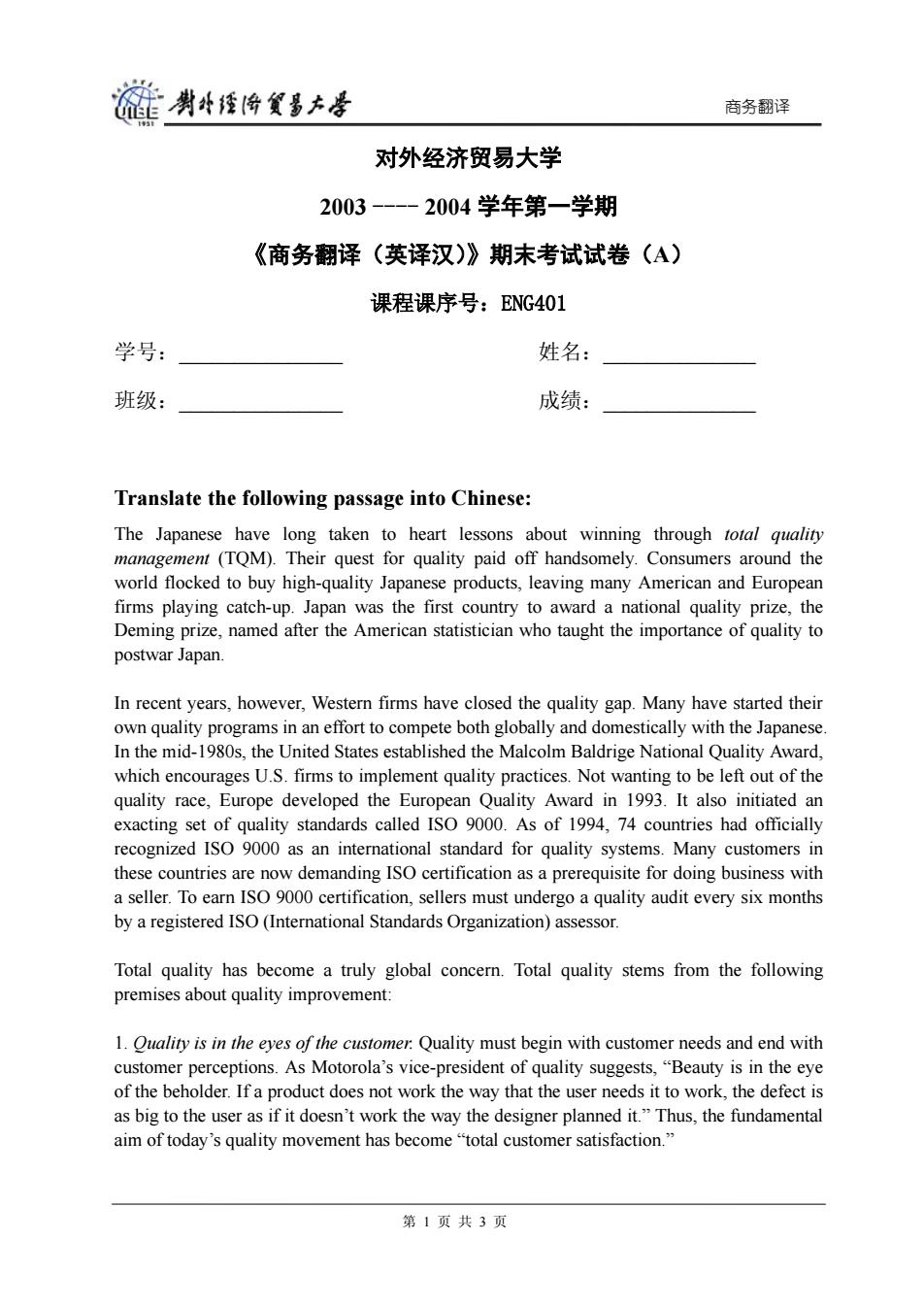正在加载图片...

莲喇母矮降贸多大学 商务翻译 对外经济贸易大学 2003--2004学年第一学期 《商务翻译(英译汉)》期末考试试卷(A) 课程课序号:ENG401 学号: 姓名: 班级: 成绩: Translate the following passage into Chinese: The Japanese have long taken to heart lessons about winning through total quality management (TQM).Their quest for quality paid off handsomely.Consumers around the world flocked to buy high-quality Japanese products,leaving many American and European firms playing catch-up.Japan was the first country to award a national quality prize,the Deming prize,named after the American statistician who taught the importance of quality to postwar Japan. In recent years,however,Western firms have closed the quality gap.Many have started their own quality programs in an effort to compete both globally and domestically with the Japanese In the mid-1980s,the United States established the Malcolm Baldrige National Quality Award, which encourages U.S.firms to implement quality practices.Not wanting to be left out of the quality race,Europe developed the European Quality Award in 1993.It also initiated an exacting set of quality standards called ISO 9000.As of 1994,74 countries had officially recognized ISO 9000 as an international standard for quality systems.Many customers in these countries are now demanding ISO certification as a prerequisite for doing business with a seller.To earn ISO 9000 certification,sellers must undergo a quality audit every six months by a registered ISO(International Standards Organization)assessor. Total quality has become a truly global concern.Total quality stems from the following premises about quality improvement: 1.Quality is in the eyes of the customer:Quality must begin with customer needs and end with customer perceptions.As Motorola's vice-president of quality suggests,"Beauty is in the eye of the beholder.If a product does not work the way that the user needs it to work,the defect is as big to the user as if it doesn't work the way the designer planned it."Thus,the fundamental aim of today's quality movement has become"total customer satisfaction." 第1页共3页商务翻译 对外经济贸易大学 2003 ---- 2004 学年第一学期 《商务翻译(英译汉)》期末考试试卷(A) 课程课序号:ENG401 学号:_______________ 姓名:______________ 班级:_______________ 成绩:______________ Translate the following passage into Chinese: The Japanese have long taken to heart lessons about winning through total quality management (TQM). Their quest for quality paid off handsomely. Consumers around the world flocked to buy high-quality Japanese products, leaving many American and European firms playing catch-up. Japan was the first country to award a national quality prize, the Deming prize, named after the American statistician who taught the importance of quality to postwar Japan. In recent years, however, Western firms have closed the quality gap. Many have started their own quality programs in an effort to compete both globally and domestically with the Japanese. In the mid-1980s, the United States established the Malcolm Baldrige National Quality Award, which encourages U.S. firms to implement quality practices. Not wanting to be left out of the quality race, Europe developed the European Quality Award in 1993. It also initiated an exacting set of quality standards called ISO 9000. As of 1994, 74 countries had officially recognized ISO 9000 as an international standard for quality systems. Many customers in these countries are now demanding ISO certification as a prerequisite for doing business with a seller. To earn ISO 9000 certification, sellers must undergo a quality audit every six months by a registered ISO (International Standards Organization) assessor. Total quality has become a truly global concern. Total quality stems from the following premises about quality improvement: 1. Quality is in the eyes of the customer. Quality must begin with customer needs and end with customer perceptions. As Motorola’s vice-president of quality suggests, “Beauty is in the eye of the beholder. If a product does not work the way that the user needs it to work, the defect is as big to the user as if it doesn’t work the way the designer planned it.” Thus, the fundamental aim of today’s quality movement has become “total customer satisfaction.” 第 1 页 共 3 页